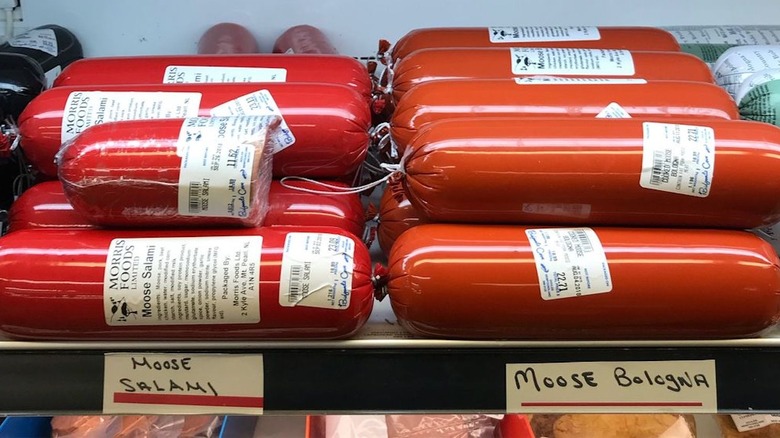How Moose Bologna Became A Staple Delicacy In Newfoundland, Canada
Of course the Canadian version of bologna would be made from moose. Why wouldn't it be?! It is not stereotypical to say that the moose is a natural icon of Canada. There are well over a million of them across the provinces and territories, symbolizing Canada's commitment to protecting its vast wilderness. And there might be no province more in touch with its wilderness than Newfoundland and Labrador, the home of moose bologna.
For a province where the word "cod" is synonymous with "fish", you might be surprised to learn that Newfoundland and Labrador consume the most bologna in the entire country. Owing to the fact that nearly all of its produce needs to be shipped in — Newfoundland is an island and Labrador is remote with a lot of coastline – meat has historically been expensive here. Bologna, a processed sausage-style sandwich meat, offered a cheap, flavorful solution. Newfoundlanders fell in love with it, treating it with the same reverence as you might treat your favorite meal.
But where do the moose come into play? Four moose were introduced to the island of Newfoundland in 1904. Over a period of 26 years, they created a population sizable enough to inaugurate Newfoundland's first moose hunting season in 1930. The population continued to grow. Today it is the most concentrated in North America, at around 120,000. Hunting for moose is another treasured Newfoundland tradition: You'll know when it's moose season when moose bologna starts appearing on store shelves.
A uniquely Canadian sausage meat
If you've ever seen a moose, you'll know how enormous they are. A full-sized bull moose can weigh nearly 1,200 pounds, giving you more than enough meat to cut into steaks or turn into bologna. It isn't exactly clear when moose became a popular meat for Newfoundlanders to make bologna out of. However, what is clear is that there has been an effort in recent years for citizens of the province to eat more local foods, such as cod, rabbit, seabirds, and, of course, moose.
Though bologna purists may scoff at Newfoundland's use of moose meat, you have to admire the fact that these islanders make use of their local ingredient to make it. Thanks to special licensure, hunters can sell moose to butchers or local food companies, where the meat is turned into bologna. The artisanal sausage makers either hunt the moose themselves, or purchase from those local hunters, and they also produce other moose-meat sausages, including salami and pepperoni. Despite being a game meat, moose is known to have a fairly mild flavor, pairing well with a host of spices.
So, while it may not be Oscar Meyer, or authentic Mortadella that comes from the city of Bologna in Italy, there is something uniquely Canadian about moose bologna. It's hard to imagine it coming from anywhere else in the world, and the Newfoundlanders seem to like it that way.

